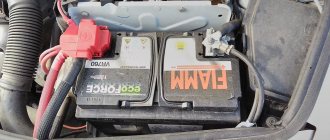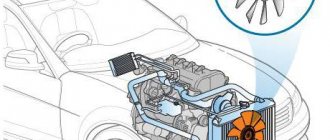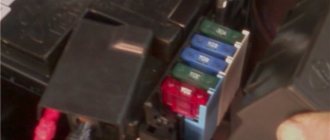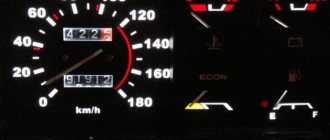Most modern cars are equipped with factory alarms. Often, a car owner buys a used car with an already installed alarm system. In both cases, the car owner may not know all the intricacies of the security system of his vehicle. A constantly burning alarm light is a sign that the car’s security system is malfunctioning. In this case, it is necessary to understand the reasons for the constantly working indicator and eliminate them in order to restore the system’s functionality.
Main reasons
There are several main reasons why the security system indicator lights up with a constant, unblinking light.
- The most common reason for a constantly lit alarm indicator is that the Valet security system mode is intentionally or accidentally turned on. In this mode, the indicator light lights up continuously. However, the car is not under security. The car owner is notified of the activation of this mode by an inscription on the electronic display of the alarm key fob.
- Another common reason for a constantly burning light is a malfunction of the limit switches (limit switches) of the opening parts of the car body, that is, in the doors, trunk or hood.
- A less common, but still common reason for a constantly lit indicator is a software failure, hardware alarm error, or failure of individual sensors.
For some alarm models, a constantly lit indicator may be associated with the activation of certain security system modes: “Panic”, “Hands Free”, with the immobilizer turned on, when starting the engine remotely, etc. In this case, removing the constantly lit indicator is quite simple. You need to set the alarm to standard security mode or turn it off temporarily.
Additional functions
There are a large number of proposals from manufacturers to supplement car alarms with additional options and functions. The most popular and frequently used are:
- Owner's feedback, which allows blocking the engine from starting in case of unauthorized opening.
- Shock and mechanical shock sensors.
- A device that indicates which door or hood has been opened.
- Remote engine start will allow you to warm up the engine and interior without the presence of the driver.
Installation of additional functions on the car is carried out in specialized service centers. The sensors are connected to the on-board computer and to the electrical network with the ability to operate autonomously even in the absence of power.
Valet mode in alarm
Various manufacturers of security systems for cars include several lighting modes for the alarm indicator in their software. In different modes it flashes, is at rest or is constantly on. Most security system manufacturers provide a Valet service mode when the car is unprotected.
Valet is primarily intended for car maintenance and repair, when the security system may interfere with car service workers. Valet can be accidentally or intentionally turned on by the car owner, in which case a constantly lit alarm indicator indicates that the car is unprotected. In this mode, the car owner can only remotely open and close the doors, luggage compartment and hood.
On some alarm models, it is enough to simply accidentally turn on the Valet mode, since it is activated from the remote control by pressing a key combination. On other models of security systems, it can only be launched from a button in the car interior.
Try our service station selection service
Creating an application is absolutely free and will take you no more than 5 minutes
Alarm failure is one of the most common car problems. At the first signs of abnormal operation of the car alarm, measures should be taken to identify the causes of failures and begin to eliminate them.
p, blockquote 1,0,0,0,0 –>
p, blockquote 2,0,0,0,0 –>
Otherwise, it is possible that the anti-theft system will deny access to the cabin or prevent the engine from starting. Let's look at the main signs of a car alarm malfunction, the causes and ways to eliminate them.
p, blockquote 3,0,0,0,0 –>
p, blockquote 4,0,0,0,0 –>
How to disable Valet
The option to disable Valet mode depends on the possible ways to enable it. It is deactivated either by pressing a button inside the car, or using the alarm remote control by pressing a combination of buttons.
Button to switch to mode
The “Valet” button can be located anywhere in the car: both in the cabin and in the luggage compartment or even the engine compartment. It is often hidden in a particularly inconspicuous place so that potential car thieves are not tempted to disable the entire security system with a simple press of a button.
As a rule, when installing an alarm, service workers check with the car owner about the desired location of the button to turn on and off the Valet mode. If the car owner does not know where such a button is located, he will have to look for it. The most expected button locations are the following places.
- Under the steering column is the most commonplace location of the button, which is also the most unsafe. The area under the steering column is convenient as the driver can press it without leaving the driver's seat. However, potential hijackers look for it first of all there. As a disguise, the button can be covered with an ordinary plug, which will also prevent accidental pressing.
- Under the driver's seat is another convenient but banal option, which is also often masked with a plug.
- In the driver's door - a dubious option, since in this case it can be accessed from outside the car.
In general, the placement of the button is limited only by the imagination of the person on whose initiative the alarm was installed. Therefore, in order not to waste time on empty searches, it is better to carefully study the technical documentation of the alarm system.
Disabling Valet mode using a button looks the same for almost all car alarm manufacturers.
- You need to start and then turn off the car engine.
- After 10 seconds, you need to press the Valet button and hold it for several seconds, or turn the switch to the “Off” position.
- The driver is notified when the mode is turned off by a double horn sound, after which the indicator light goes out.
Combination to turn on Valet
Another option for disabling the Valet mode of the car alarm is possible using a remote control, that is, a key fob. To do this, you need to press one of the key fob key combinations, and the key combination, as well as the sequence and duration of pressing, can vary significantly among different manufacturers of security systems.
The exact combination for disabling the service mode in a specific security system model can be found in the car alarm user manual. The key combination for the most common car alarms is as follows.
- For security systems of the popular Scher-Khan brand, turning on and off the Valet mode is done by simultaneously pressing and holding buttons 1 and 3 for one second. You cannot overpress, since pressing these buttons for 2 seconds will turn off the shock sensor.
- The Valet mode in the StarLine family of alarms is disabled by pressing button 2 once.
- In Tomahawk car alarms, the mode is turned off by pressing the Z button; usually you need to press it twice - once once and once while holding the button. For some alarm models of the company, the method of disabling may differ, so you should first study the manual for using the specific security system.
- For Alligator brand alarms, the mode is turned off by simultaneously holding buttons 2 and 3 for 3 seconds.
General Tips
p, blockquote 53,0,0,0,0 –>
If a car alarm periodically begins to malfunction, you should check the quality of the electrical wiring to it and replace the batteries in the key fob. If the problems continue, you should consider replacing the security system. The standard trouble-free operation of the alarm system is 5-7 years.
p, blockquote 54,0,0,0,0 –>
Store the keychain in a dry place, do not leave it in an unheated, damp garage. The key fob is the weak point of the alarm system.
p, blockquote 55,0,0,0,0 –>
See how to measure leakage current in a car with a multimeter and why it is dangerous.
Why is a flash drive sometimes not readable by the car radio and how can this be fixed?
Video - how to set the car alarm or disarm it using the VALET button (if the key fob does not work):
p, blockquote 57,0,0,0,0 –> p, blockquote 58,0,0,0,1 –>
Mechanical damage to the alarm
Mechanical damage, manifested by a constant lighting of the indicator, is usually associated with limit switches (limit switches) of the doors, luggage compartment or hood. Limit switches are the simplest opening-closing sensors, which are buttons connected to an alarm system. In the closed position they are pressed and close the electrical circuit; in the open position they open. Damage to the limit switches can be caused by:
- oxidation of contacts in conditions of high humidity or in winter;
- loose fit as a result of deformation of the body part due to an accident or improper installation;
- failure due to mechanical impact or impact.
When the electrical network is disconnected, the alarm perceives the body part as open. As a result, the alarm indicator light lights up continuously.
On modern cars equipped with a display, identifying the problem of an inoperative limit switch is quite simple. In a graphic image of a model car, a door or body part with a non-functioning limit switch will also be displayed as not closed.
To solve the problem, you need to visually inspect all the limit switches of the car for contact oxidation. If an oxidized limit switch is detected, it must be disassembled and the contacts cleaned.
If the cause of the limit switch malfunction is mechanical damage, then it needs to be replaced with a new one. If incorrect positioning of the limit switch is detected, the position of the limit switch must be adjusted to that required for proper operation.
Why do light bulbs in spotlights and chandeliers burn out quickly?!
Hello! Today I want to talk about how to correctly connect and properly operate spotlights, chandeliers, sconces, etc.
I will also try to explain clearly why light bulbs burn out quickly. Today, due to violations during the installation of electrical wiring for lighting, the issue of quickly burning light bulbs is becoming more and more acute.
I’ll probably start with spotlights
since this is the most popular method of lighting in modern apartments, and spotlights are placed not only on the ceilings to illuminate the apartment itself, but they are also installed in various furniture for lighting - cabinets, sideboards, kitchen units. The list can be endless.
Why do light bulbs in dots burn out so often?
And there can be many reasons for this disease, especially if you have halogen light bulbs. Such lamps are especially capricious if installed incorrectly.
1) The first reason is the incorrect connection diagram of the spotlights. When all points are connected to one wire one after another. With this scheme, the load of each subsequent lamp falls on the connection of the previous one. And the total load of all lamps falls on one wire. This can be seen in the diagram.
This connection diagram is not correct, and often leads to rapid burnout of conventional incandescent and halogen lamps. But nevertheless, this scheme is used everywhere and by everyone, from lighting in cabinets to room lighting.
What happens with such a connection? And this is what happens: Let’s say that on the first light bulb on the side of the distribution box, the contacts of the socket have oxidized due to the strong heating of the halogen lamp (the temperature there is very high, and the socket is naturally Chinese - overheating cannot be avoided), then a chain reaction begins, the wires coming from the socket gradually begin to heat up, then the connection to the common wire heats up. And when the connection heats up, oxidation of the wires connected to each other will not take long to occur. Here the following lamps also put a large load on the already heating connection. Accordingly, due to heating and subsequent oxidation of the connection, the resistance between the connected wires increases, voltage drops occur on this line, which lead to frequent burnout of light bulbs.
And with the correct connection diagram, a separate wire goes from the junction box to each lamp. In this case, the load is distributed evenly. Seen in the diagram below
But if you have completed a version of the first scheme and there is no way to fix it, then I recommend this procedure to my clients: I remove the spotlights from the ceiling (cabinet, headset), cut off the oxidized part of the wire and throw out the old sockets from all points, install new ones cartridges and connect the chain. But I advise you to abandon halogen and incandescent lamps, otherwise the problem of burnout with such a connection scheme will not be long in coming again. And I install LED lamps instead of halogens.
They are not afraid of voltage surges, although surges will not occur, since LED lamps are slightly above room temperature, even with prolonged use. And they work for up to five years. The average price of such a lamp in Ufa is 200 rubles, which will easily pay for itself over a given period of operation. At the same time, you will save on electricity, since LEDs consume significantly less incandescent and halogen lamps (virtually none at all). So you are saved. Everything is easy and simple to treat.
The most important thing is that LEDs come in a variety of shapes, so you can easily match them to your old fittings from spotlights.
This is another savings.
And we move on to the second reason for frequent lamp burnouts.
2) The second reason,
is caused by poor connection of spotlights to the supply wires. These are the so-called twists (this is usually always done). If you simply twist the wires, even the correct connection diagram will not help; the light bulbs will still burn out (halogen, incandescent lamps).
What happens when twisted? I'll try to explain now. The first thing that comes to mind is the natural oxidation of twisted wires; even with very tight twisting, darkening of the copper is always visible; the wires literally turn dark over time. This is not visible to the naked eye. And oxidation leads to an increase in the transition resistance at the junction of the wires. Again, this all leads to a voltage drop and rapid destruction of the lamp.
But there is another reason not to put wires on twists, and this reason is called “Eddy currents” that arise in our twist, since it is something like a “coil-inductor,” roughly speaking. Well, as always, this leads to interference and further, further, further to consequences that you already guessed.
Well, it’s also not difficult to treat. The lamp is removed from the ceiling, the socket is replaced, the twists are cut off, and the wires are reconnected, but already tightened through the immortal terminal block.
Well, when you combine these two rules (circuit and correct connection), even halogen lights will work for a long time. Although they usually combine not two rules, but these two errors. Brrrrr, this paradoxicality even makes it unpleasant.
And now I’ll move a little away from the topic of burning light bulbs, and come to the case when the light disappears simultaneously in all lamps. Usually this happens quite often, but don’t rush to buy new light bulbs, because most likely it’s not them.
Usually the reason for the simultaneous shutdown of the lamps is either a break in the power cable, or most likely your step-down transformer has malfunctioned.
Such a transformer is installed if the fittings and halogen or LED lamp are designed for a voltage of 12 V. And since transformers are usually selected mainly at the lowest price, they often fail. Over and over again, after each breakdown, owners have to call a technician to replace the step-down transformer. In this case, I suggest that the owners replace the torment with the transformer by completely removing it and connecting the lamps directly. But at the same time it is necessary to replace 12-volt light bulbs with 220-volt ones.
Let's move directly to the chandeliers
Namely, let’s first consider Chinese budget chandeliers with LED lighting, halogen bulbs and a seductive control panel.
Such a filling at a low price naturally gives rise to a lot of problems regarding the quality of the product. And in the first place we have burnt out halogens (light bulbs), this problem is the first symptom of a complete breakdown of the chandelier. The reasons are basically the same - first, due to severe overheating from the lamps, the contacts of the sockets lose their elasticity (this is due to the quality of the metal of the contacts), when elasticity is lost, the contacts weakly compress the pins of our halogen lamps. Which leads to poor contact and further, constant burning of the lamps. You can come to terms with all this, and light bulbs, in principle, are not so expensive, you can buy them, but the harmless combustion of light bulbs is being replaced by another, more serious one. After this stage, the electrical wiring in the chandelier begins to get very hot, and since the wiring in it is very thin, they literally smolder. And when the time comes for the insulation to melt, the entire bundle of wires fuses together, thereby causing a short circuit. In some cases, the chandelier completely stops working because the step-down transformer fails; in some situations, several lamps remain working, or only the backlight works. In this case, it is necessary to change all the wiring of the chandelier, as well as the sockets and the transformer with the control unit. But this process is quite labor-intensive, and most often it is not possible to remove the cartridges.
By the way, exactly the same problem occurs with chandeliers without remote control. Only you no longer need to replace either the transformer or the control unit.
Malfunction of programs or sensors
A fairly rare, but possible reason for the indicator to be constantly on is a software failure or malfunction of individual sensors. Special security system meters include sensors for mechanical impact (shock), changes in volume in the cabin, body position, etc. If one of the sensors breaks down, the system perceives the situation as an emergency, which notifies the car owner using an indicator. In this case, to diagnose the faulty sensor, you will have to contact a specialized service.
Also, a constant indication may be caused by a software or hardware error in the electronic alarm control unit. You can try to reset the alarm by turning off the battery power. If the problem persists, it is difficult to solve it yourself, so it is better to contact a service center
In any case, the constant burning of the indicator light is a sign that the car is not under reliable alarm protection, therefore, the safety of owning the car is reduced. By finding the reason for the constant light of the indicator and eliminating it, you can restore reliable protection for your car using a car alarm.
Factors affecting the longevity of light bulbs
To extend the service life of LED lamps and prevent burnout, it is necessary to ensure high-quality heat removal. This is the only option possible or available to the user to protect them from burnout. You should follow basic rules for caring for lamps:
- Clean appliances regularly, possibly using a vacuum cleaner;
- do not use liquid detergents;
- service only when the lamp is switched off;
- LED strips should be installed on a special aluminum profile that serves as a heat sink;
- To connect lighting fixtures in office or public spaces with a large number of units, seek help from employees of specialized organizations.
Technical and software problems
In conclusion, we wish that from now on you will never again be tormented by the question of why the alarm light is constantly on, as well as a restful sleep at night without worrying that someone will take your “iron friend” away.
Nowadays it is difficult to find a car without an alarm system. Some receive a security system at the factory, some later - at a service station. But there are situations when everything was still working yesterday, but today the alarm light is constantly on or blinking. What to do and is it necessary to do something in such cases?
The LED is constantly on, the alarm does not respond to key fobs
car Chevrolet Orlando, alarm system A94.
Answers 7
It looks like the alarm is in Valet mode, and the key fobs are either disconnected from the alarm or the antenna is turned off. Try linking the main key fob to the alarm. Press the Valet button on the alarm 7 times, then briefly press 1+2 buttons on the key fob. In Valet mode, in theory, it won’t bind. But you have to try. And then holding button 2 for a long time will take you out of Jack.
The LED is constantly on.
The key on the key fob does not light up.
If, however, when you press button 1 of the LCD key fob, the door locks are locked/unlocked. If the security is not activated, then you need to turn off the Valet mode with the KEY FOB. To do this, quickly short press button 4 to move the cursor to the icon with a wrench and then briefly press button 2
as for advice
And then holding button 2 for a long time will take you out of Jack.
then this is true for the A92 with the same external key fob, but different functionality.
The key fobs themselves work, all the icons are lit, when you press button 4, the cursor moves as expected, when you press the call button on the antenna module, the turn signals blink. The alarm system does not respond to key fobs at all. An attempt to attach the key fob was unsuccessful. The question is: in this mode, can I reflash the CM to reset to factory settings?
Perhaps your antenna wire is broken.
In this mode, can I reflash the CM to reset to factory settings?
could end badly. And will add new breakdowns.
An attempt to attach the key fob was unsuccessful.
Source
The LED flashes when the ignition is on
Good day!
The LED flashes when the ignition is on. When the door, hood, etc. opens. I also noticed that it also blinks at speed. It's unnoticeable during the day, but at night it causes discomfort. I have already read other topics, the slave mode is disabled, but the LED is still blinking.
Answers 5
The LED flashes when the ignition is on
When the door, hood, etc. opens
No, when I open the doors, etc. it flashes. This is normal behavior, as I understand it, but the fact is that in the dark it interferes. And the question is, is it possible to turn off this blinking?
I've already read other topics, slave mode is disabled
This is done for safety reasons (flashing when the door is open). cannot be disabled.
When the door, hood, etc. opens. I also noticed that it also blinks at speed.
And the question is, is it possible to turn off this blinking?
because another colleague is also right
Source
A93 the feedback key fob periodically receives a signal about arming the alarm system
Starline A93 periodically receives a signal about arming the alarm system on the feedback key fob. The key fob screen lights up, the key fob makes a short squeak, but there are no more signals. My notification channel control is turned off, I checked.
The video reproduces the behavior of the key fob at this moment.
In the same way, the key fob will blink and squeak if you send a signal from an additional key fob to set the alarm. The key fob beeps only next to the car, which means some signal comes from the alarm system and the key fob is working. Fed up with beeping 10 times a day, then everything is fine for a week.
Answers 33
I checked it, it didn't help. Problem still exists.
The photo was taken a minute after the squeak. He can beep 10 times an hour, or he can be silent for 2 days.
and the block itself is hidden too deep under the torpedo.
the block is under the instrument panel and the ground is screwed here (possibly loose)
Could this influence this behavior?
I reset the terminals from the battery, the sound of the key fob is different. When resetting the battery, the sound is like when you press button 3, but for me the sound is like when you press button 1.
dumped in security /
Yes, I reset it when the security system was set.
SC removed himself from the problem
The signaling system is about to be demolished, it’s not 3 years old. I didn't think everything was so bad with Starline
1) I press button 1, the alarm is set to armed and a signal comes to the key fob indicating that the alarm is installed (short squeak, blinking of the key fob, etc.).
2) I press button 3, the key fob asks for the temperature in the cabin and the battery voltage, this information comes to the key fob (trill, battery and temperature indication).
I don’t know why signal 1 comes to the key fob without a request, but is it possible to turn it off forever?
Try re-registering the key fobs.
Tried it, didn't help
The signaling system is about to be demolished, it’s not 3 years old. I didn't think everything was so bad with Starline
BRAND SERVICE (Brand Service LLC) Surgut, st. Profsoyuzov, 25 Mon – Sun: from 8:00 to 20:00 +7 [email protected]
They can also check the key fob if necessary.
SC removed himself from the problem
Because recharging the key fob is quite possible if the battery in it is bad.
Source
Limit switches
Before writing about limit switches, it is necessary to separately mention a feature of the Starline security system. At a good speed, in some cars the air flow, running onto the hood, can lift it slightly. But the Starline hood contacts are located in such a way that the alarm light will light up while driving, indicating that the hood lid is “not closed.”
You can also note the limit switch on the trunk of cars in which the Sherkhan system is installed. While the trunk is not tightly closed (for example, due to non-standard cargo), the blue light on the Sherkhan alarm will be constantly on.
This is what a trailer might look like.
If the owner has checked the “immobilizer” functions and is sure that the service mode is not enabled, it is necessary to check the limit switches of all doors, and not just the hood. If the contact is oxidized, dirty, or the cover presses on it with insufficient force, this is the second reason why the light on the alarm is on. Checking and cleaning usually solves the problem, after which the light goes out.











